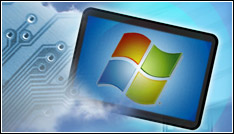Microsoft has disclosed some of the changes it will make to Windows 8’s power management capabilities.
Of course, every company aims to tweak successive generations of its products. Windows 7 offered a reduction in power use over Windows XP for example.
However, if everything goes according to Microsoft’s plans, Windows 8 will eventually appear on a variety of consumer-centric tablets – a relatively unexplored market for the company, and one with its own set of demands. Chief among them: power efficiency. After all, nobody likes it when his or her tablet dies after two hours of sustained use.
New Ground
In a fairly radical change from previous editions of the operating system, Windows 8 will offer a start screen of colourful, touchable tiles linked to applications. This serves the tablet side of the equation; in addition, the platform includes the ability to flip to a “traditional” desktop interface familiar to anyone who’s used Windows before.
 According to a 8 November post on Microsoft’s official Building Windows 8 blog, Windows 8 (due to roll out in 2012) will tweak its software for power consumption in three ways: “The Metro style app model, idle hygiene, and a new runtime device power-management framework.”
According to a 8 November post on Microsoft’s official Building Windows 8 blog, Windows 8 (due to roll out in 2012) will tweak its software for power consumption in three ways: “The Metro style app model, idle hygiene, and a new runtime device power-management framework.”
In other words, Microsoft claims its Metro style application model – the one driving those touch-friendly applications – is designed from the ground up for power efficiency, with the ability to suspend background applications in order to save battery power.
Idle hygiene constitutes what Microsoft calls “improvements in idle activity,” increasing the time of idle states. Meanwhile, Microsoft’s revamped device power framework integrates the hardware’s power-management capabilities through a driver known as Power Engine Plug-In (PEP).
“The PEP is provided by the silicon manufacturer and knows all of the [system on a chip]-specific power-management requirements,” read the blog posting, referencing the system-on-a-chip architecture that will power Windows 8 on a percentage of tablets. “This allows device drivers like our USB host controller or a keyboard driver to be built once, and still deliver optimal power management on all platforms from SoC-based PCs to data centre servers.”
Tablet Focus
Microsoft’s focus on power management hints at the effort the company will devote to smaller and energy-hungry form factors when it comes time to release Windows 8.
At September’s BUILD conference, Microsoft offered attendees a Samsung-build tablet running a developer preview of Windows 8. The 11.6-inch device featured SDK applications, a “recovery environment,” a dock to connect with a keyboard or dual monitor, and a 64GB solid-state drive.
In conjunction with optimal battery life and interoperability with Windows 7 applications, Windows 8 tablets with that calibre of hardware could appeal to both casual users who want a fast and versatile touch-screen, and IT pros who need such a device to perform a wide variety of heavyweight functions.
The question is whether any device, no matter what its operating system, can possibly be all things to all users. Apple decided to make the iPad a streamlined mobile device, instead of larding the form-factor with all manner of ports and hardware; it runs a variant of the iOS operating system that also powers the company’s iPhone. In a similar manner, most other manufacturers chasing the tablet market decided to embrace Google’s Android operating system, which originally ran on smartphones.
Those companies that decided to build a tablet loaded with Windows 7, with an eye toward offering a “desktop replacement” device, managed to gain a very small audience within the enterprise but not widespread consumer adoption.
Microsoft’s goal with Windows 8, obviously, is to build on that tiny core of business customers while attracting large numbers of consumers. Achieving that goal, in part, requires an operating system with optimal power use.




